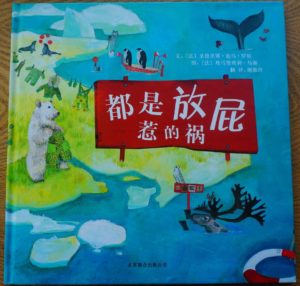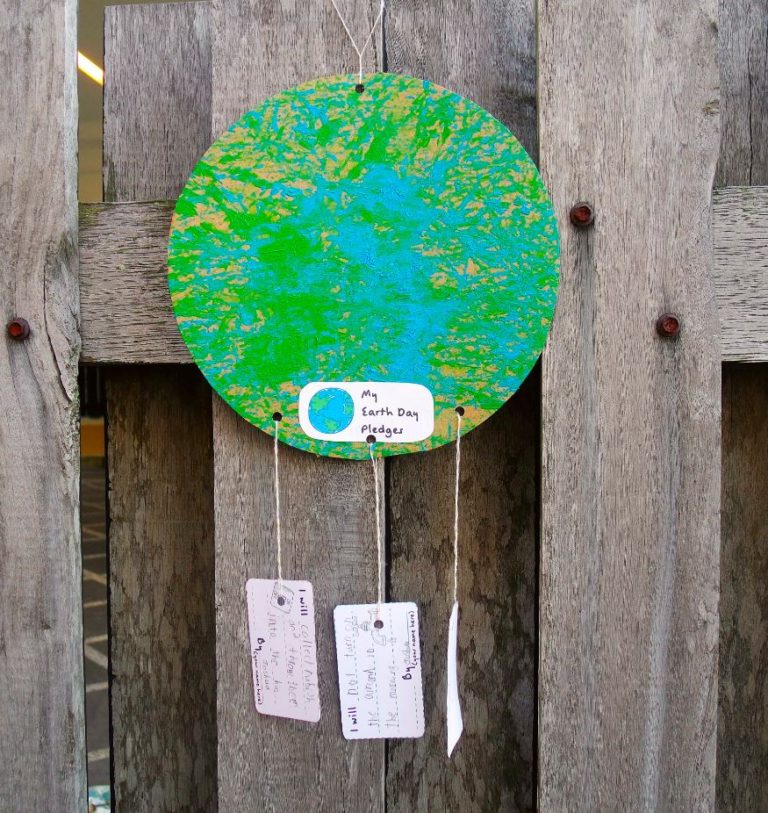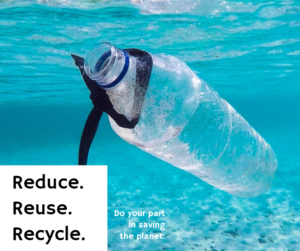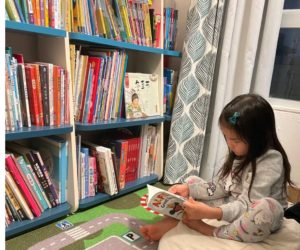Earth Day has just passed by, where various global communities and schools participated in activities and discussions raising awareness regarding environmental protection. Axel came home from school one day asking me what global warming is – I mean, I have read about it here and there, but media articles on environmental matters are often biased and I didn’t want to bluff my way through, as it will be a topic that our children will keep coming across as they grow up. Since one never stops learning, it became a great opportunity that we learn more about it together!
We embarked on a journey looking for answers. For young children, picture book is often a good way to start, and I found this great book just served the purpose: “都是放屁惹的祸” written by a French environmental issues journalist Sandrine Dumas Roy (translated English version is named “Hot Air”). This book touches on the complicated and controversial topic of climate change in a humorous way where children can easily resonate with, yet illustrating the difficulties on how countries tackle a global issue affecting all. The story is left open-ended and acts as a great conversation starter with our children, such as “What would you do?”.

In fact, the moment we finished reading the book, Axel gathered that cow’s farts and burps contributed to greenhouse gases and decided “never ever drinking cow’s milk again” in hope of playing a part to help – an outcome I certainly didn’t expect! The family agreed to support his decision and started providing the alternative soy, oat or almond milk instead for breakfast.
A few days later, we sat down to watch a documentary together about the earth’s long-term rise in average temperature (i.e. global warming) and melting ice caps at an unprecedented rate. It was a powerful image, and the resulting threats in the livelihoods of animals such as polar bears and walruses provoked Axel to start shedding tears…
This reminds me of a video that went viral over the internet a few years ago, where Henry Marr, a 6-year-old boy at the time getting really upset after watching a video at school about the harmful impact that humans have on the environment, and how he wanted to be an adult right away so he could start acting on it and stopping people from harming the environment:
Since young, Axel has been a sensitive child, probably more so than his peers and would easily get emotional especially on things that he can personally relate to. I believe he might be one of the 15-20% of children that are described as ‘Highly Sensitive’ by Dr. Elaine Aron who has conducted scientific research and written a book about it (also translated into Chinese amongst many other languages).
“These children are born with a nervous system that is highly aware and quick to react to everything. This makes them quick to grasp subtle changes, prefer to reflect deeply before acting, and generally behave conscientiously. They are also easily overwhelmed by high levels of stimulation, sudden changes, and the emotional distress of others.”
If you have kids encountering similar experiences, you may want to find out more about it on her website and here is a simple diagnostic questionnaire derived by Dr. Aron. I don’t think we need to label our children as such, but having a better understanding and equipping ourselves with ways to guide our kids certainly help. (p.s. this is just my personal sharing and I have not been paid to reference this)
It is great that some children have found a passion in protecting our Earth as we only have one, amongst many other reasons. To help Axel get through his emotional unease, it was key to give him a fuller picture to understand the issues and causes of global warming and what we can do about it. Here is a sharing of our findings in brief and simplistic terms and what we did together:
- Understanding the issue: Greenhouse gases in the atmosphere hinder heat radiation from Earth to space hence accumulating heat on the earth’s surface. Key contributing components of greenhouse gases are carbon dioxide (CO2) and methane (CH4), mainly caused by the burning of fossil fuel and deforestation, with the latter caused by agriculture such as cattle farming respectively.
- Act on it: Brainstormed together and discussed what we could do to help as individuals. Start with small and practical things that children can execute on their own, e.g. switching off the lights when not in use, water conservation such as turning off tap when brushing teeth etc. Remember “Little by little, a little becomes a lot”. Be a good listener and let your child get creative as well!
We also did a simple and fun Earth Day Pledge craft where we wrote down the “little things” we decided to do and hang up as a constant reminder to carry them out. Watch our craft video below for inspirations!
- Lead by example: Children often turn to their parents for guidance and learn best by observing them – share your views on the environment topic and carry out your pledges together! This would also establish a good rapport between you. Imagine what message it sends if your child is trying to conserve electricity whilst you often leave lights on at home when not in use!
- Participate in local events related to the environment: We attended a local exhibition about climate change, and also joined a meet up to pick up plastics and rubbish on a beach. Through these you also get to meet like-minded people where your child can ask questions, discuss and share the same passion.
Fun and Simple Earth Pledge Craft
Most importantly, tell your kids they are not alone in feeling passionate and possibly emotional about environment issues. In fact, during my research on the topic, I discovered some adults are also affected by it emotionally and is termed as ‘climate grief’. Building community, talking openly about the problem and how it affects them and taking actions helps.
Not to panic if your children do not feel much for the environment, as everyone’s passions lie differently and do change at different points in life. However, I do believe all children should be climate-conscious and understand the matter at hand and play a role in their own ways. In particular parents, caregivers and teachers have vital roles to play in educating and influencing our next generations on the climate change topic positively and constructively.
Should any of you are also fans of the drama TV series Game of Thrones, the climate change situation feels almost like quotes from the series “Winter is coming”, and “When the snows fall and the white winds blow, the lone wolf dies but the pack survives.” Whilst countries are fighting their own battles and individuals getting on with daily lives, nothing matters if we were all dead and cities are under the ocean.
Food for thought.
(Wondering how Henry did after his meltdown? Check it out here.)





